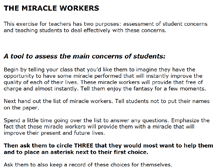A Curriculum of Concerns
Your content has been saved!
Go to My Saved Content.Most excellent teachers have learned what first-rate filmmakers have always known, that to be successful you need to reach your audience emotionally. I want to revisit one the best approaches I know, emphasizing its application at the secondary school level. The purpose is to increase student motivation and foster healthy emotional development.
Teachers know that making lessons relevant helps motivate students. The most frequent approach is to link curriculum to learner interests. As an example, if kids are interested in hip-hop music or in competitive sports and you weave those into your lessons, you'll increase student motivation.
But two educators, Mario Fantini and Gerry Weinstein, in two now out-of-print books, Making Urban Schools Work and Towards Humanistic Education, pointed out that it would be more effective to link curriculum to the concerns of learners. (You can find used copies of both through Book Finder.) What do kids worry about? What anxieties sometimes keep them up at night? What peer interactions churn up their emotions? How do they deal with their fears about the future, college admissions, employment or bullying?
Fantini and Weinstein found that adolescents' concerns fall into three categories:
- Identity
- Connectedness
- Power
We know that adolescents wrestle with figuring out who they are and what their direction is for the future. Relationships with others, acceptance and rejection, and intimate relationships are dominant concerns for many. And kids often struggle with feelings of powerlessness related to their ability to control their lives and determine their futures.
Assessing Student Concerns
Step one is assessment, finding out the concerns of your students. Some concerns are normal for the age group, and of course teachers should always be aware of those concerns. But concerns are often influenced by the social milieu, the family and the dominant peer group. You need to discover the primary concerns of the kids you teach.
Just asking for the information in an anonymous written assignment doesn't often work very well. It can be difficult for adolescents to articulate their concerns to themselves, let alone a teacher, however accessible you may be.
If you establish personal journals as a regular process in your class, and also create an environment where students feel free to selectively share some journal excerpts with you through letters or emails, you may be able to get better information. Roger Hiemstra and Melissa Kelly offer some guidelines on how to proceed with this.
I prefer using an indirect, low-risk and fun approach, so I designed an exercise that can be used both for assessment and as a springboard for teaching kids to deal with the concerns. It's entitled The Miracle Workers. I've found that, in addition to being more fun, this provokes thought and provides options for follow-up.

Students are given a list of fictitious miracle workers and told to imagine that each one can work a miracle for them. They're asked to select the three who would be most valuable to them and to designate one of those as their primary choice. The names of each are designed to be humorous. For instance, Sir Vival provides street smarts and "Pop" Larity . . . well, you get it!
I hand it to students, have them anonymously make their selections, and also write these selections in their journals. Students who have a concern that they think was omitted can add it and even come up with the name of a new miracle worker if they'd like. I collect the sheets and tabulate the concerns to determine which are dominant. Since students will be interested in the results, I spend time sharing and discussing them the next day
(Click the above image to download a PDF of the exercise and a number of ways you can employ it.)
Applying Student Concerns to Increase Motivation
So now what? Once you know student concerns, you need to incorporate them into your lessons.
Language Arts
In language arts classes, it's easy to find readings that relate to the concerns of the students. There are many superb young adult novels that specifically address the concerns of kids. Most of them are so good that adults can also appreciate them. The website Complex is just one of many helpful resources for identifying this material.
If you're a foreign language teacher, you probably know the territory of young adult literature in the language you teach better than I do, but this edition of The ALAN Review is one interesting source that I discovered.
If you're required to teach a book that doesn't relate to the lives of your students, at least find a way of providing supplementary options. Use any wiggle room you have!
There are no formulaic answers to any of this, which means doing the minimal online searching needed to find books they can relate to, or consulting with your school librarian.
Equally important, writing assignments and video productions are great ways of addressing your students' concerns. As one example, the California Film Institute's My Place program helps kids tell their stories through video. The work is illustrative of what could be done in schools as well.
History
In history classes, consider organizing your curriculum around issues. If you do this rather than relying purely on chronology, it becomes easier for your students to find significant connections. Issues related to equality, violence, and power versus powerlessness are just a few of the many learning approaches that you can connect to learner concerns.
Science, Math and Art
In the sciences, there will be opportunities to address concerns related to health, diseases and diet, or natural disasters. In math, the greatest concern is usually the subject itself. Math anxiety is something that needs to be addressed by every math teacher.
And of course, there are numerous ways of engaging students in art projects, especially drawing, painting and collages, to express their concerns.
Directly Addressing Student Concerns
One other way of attending to student concerns is the direct route. Although that's an extensive subject, here are a few preliminary ideas.
In my classes, I had students imagine a dialogue with their primary miracle worker in which they told the miracle worker why they needed the miracle. I also had them address the question, "Since there are no miracle workers, what personal resources do you have for dealing with your concern, and how can you help make this 'miracle' happen?" That latter question became the subject for considerable exploration, individually, with a partner or two, and sometimes with me.
This also points to the importance of creating an environment of openness and trust, a subject I'll revisit in more depth in a future blog post. In this type of classroom environment, there will be many opportunities for students to talk about their concerns directly, both with you and with other students around whom they feel safe.
Challenge Day is a process that many schools have used to help build this environment across a whole grade level or even a whole small school.
This is a vast and rich territory. To explore it and apply what we discover begins with an understanding of why we're exploring. Discovering the concerns of our students provides us with an opportunity to increase their motivation and help them take more control over their own lives.
